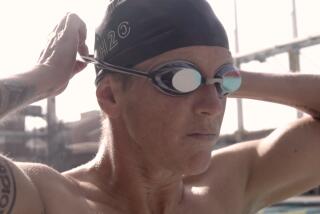It’s No Secret: Steroid Use by Athletes Is Pandemic
- Share via
IN SPORTS, steroid use varies widely from the prep level to the pros. More than 6% of the male high school students in America have taken steroids, according to a study conducted this year by Prof. Charles Esalis of Pennsylvania State University. Of the 3,360 playoff- or bowl-bound college athletes tested by the National Collegiate Athletic Assn. in 1986, 26 tested positive for steroids. Twenty-five of them were football players, including All-America linebacker Brian Bosworth. Those who, like the Boz, went on to the pros might have felt right at home; estimates of steroid use among professional linemen and linebackers run as high as 50%.
While other team sports such as baseball and basketball remain essentially steroid-free, athletes have tested positive for the drug in sports as varied as cycling and track and field. The sport in which steroid use is most pronounced is weight-lifting. Dr. Gloria Troendle, a senior medical officer with the U.S. Food and Drug Administration, estimates that 80% of weight-lifters and body-builders use steroids.
The man who brought steroids to American weight-lifting was Dr. John Zeigler. Bob Goldman, in his book, “Death of an Athlete,” writes that in the early 1950s Zeigler served as physician to the U.S. weight-lifting team. Traveling to championships, he learned from his Soviet counterparts that steroids provided added strength. Goldman says Zeigler, a decorated World War II veteran and ardent Cold Warrior, wasn’t about to let Soviet lifters have an edge. So he introduced steroids to lifters at the York, Pa., Barbell Club. They were an immediate hit.
Now many lifters openly advocate the use of the drugs; those who don’t use them complain that steroids make for unfair competition. “I set the world record dead-lift at 310 pounds,” says Judy Gedney, who competes in the 97-pound weight division. “Within a year a woman who admitted she was on (steroids) set the record at 365 pounds. Now world records are beyond the hope of non-drug users.”
To deal with this issue, Gedney and other drug-free lifters decided to set their own records. In 1983, the American Drug-Free Powerlifting Assn., based in Chicago, was born. Gedney says that before competing in association-sponsored meets, athletes are subjected to urine and blood tests and a polygraph. “It’s not a moral issue for me,” says University of Texas kinesiology professor Terry Todd, a former lifter who supports the drug-free league. “It’s a question of an even playing field.”
As the primary sanctioning bodies began to implement mandatory drug-testing--the International Powerlifting Federation in 1982 and the U.S. Powerlifting Federation in 1985--steroid users decided they needed a playing field of their own. Three years ago some of them formed the American Powerlifting Federation, which forbids drug-testing. Not surprisingly, some of its leading lifters have been charged with trafficking in steroids.
The National Football League started mandatory steroid testing in 1987; it tests all college recruits, and all pros are tested at fall training camp. The National Hockey League, National Basketball Assn. and Major League Baseball have no policies concerning steroid use.
The NCAA has two testing programs. One, in effect since January, 1986, tests athletes competing in collegiate championships and postseason bowl games. Evidence of steroid use can result in at least 90 days of suspension. The second, which started last January, is a voluntary, off-season testing program only for football players.
At the high school level, there is no nationally coordinated policy. While the Penn State study found that steroids were popular among non-athletes (30% of those acknowledging steroid use were not members of sports teams), some observers of prep sports say the study’s numbers are low. “I estimate that 30% to 40% of high school football teams in California have students using steroids,” says Al Forthmann, the Glendale Unified School District’s coordinator for physical education, recreation, athletics and substance abuse. Studies have found that the use of steroids can stunt the growth of undeveloped high school athletes, as well as aggravate acne and cause testicular atrophy.
Football coaches at perennial local high school powerhouses Carson and Banning say their players--some of whom weigh as much as 270 pounds--do not use steroids. As for high school body-builders, the man in charge of the teen-age California body-building championships says forcing the competitors to submit to a drug test would impugn their integrity. “Unless I’m told, I don’t assume they’re on steroids,” says David Smock. “I might be slandering them that way. I want to assume everyone on stage is natural.”
In the highly unlikely event that one of the youngsters was found to be “juiced up,” Smock says, the penalty would be light: “It’s not like Nathaniel Hawthorne. They don’t end up with a scarlet S on their foreheads.”
More to Read
Go beyond the scoreboard
Get the latest on L.A.'s teams in the daily Sports Report newsletter.
You may occasionally receive promotional content from the Los Angeles Times.










